#temple based designs
Note
not a question but i'm losing my mind a little bit over airbender gojo.......in lok we learn that airbenders can unlock the ability to fly by severing all earthly tethers.....and what happened to gojo's tether? his one and only???? can he fly because he killed suguru? i'm not okay
that would be a good theory!!! if gojo was an airbender :3
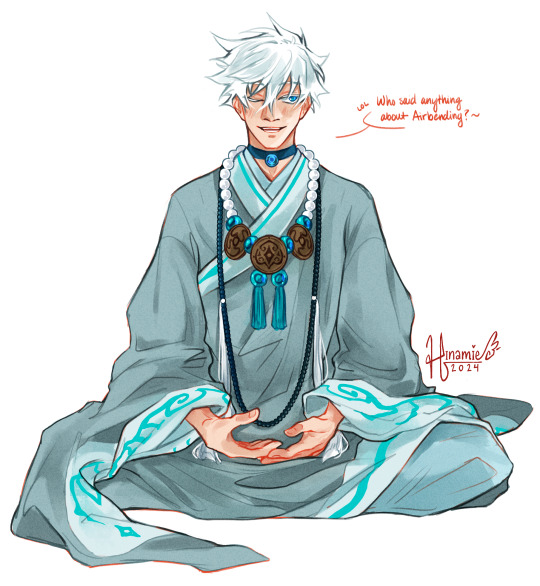
jjk atla!au with @philosophiums
#my art#answered#weeping-wandrian#jujutsu kaisen#jjk#fanart#jjk fanart#gojo satoru#gojo#jjk atla!au#atla!au: art#atla!au: illust#lmhs#i understand the confusion given that i did base his robes off the air nomad monks and buddhist monks in general#again circles back to his design origins of me just . not wanting him in orange gjhgdfhgsd#so i did kind of just colour swap them . and i stole their necklaces#in-universe u can chock it up to him chilling at the air temples most of the time :)#also re: him flying/levitating i feel that gojo just does that in any universe . any bending aside it felt Right#anyway ya ! in another timeline where i caved and accepted orange gojo he probably /would/ have been an airbender !#but in this timeline........ :)#is gojo a spirit hina
355 notes
·
View notes
Text

wanted to make some design refs for myself of baby durge, cult leader durge, and assassin durge :]
#middle design is based on. a single mtg card i found online#baldurs gate 3#bg3#the dark urge#durge#dark urge#dragonborn#my art
150 notes
·
View notes
Text
Ok so 😅 I did the blue nautolan as requested, but then once I was done I liked the base design so much I wanted to do the rest. (If this was a real game obviously the outfits would be changed under the outfits tab and not just by switching skin colors. And there would also be options for different ties/ribbons for their tendrils.) also the eyes all look so similar but they’re really red/black/brown ha 😅 (green and orange both have red eyes but you can barely tell) And you know… the colors are maybe more saturated than in live action but this is more colorful a la Young Jedi Adventures or Rebels.
I’m probably not gonna do a video like this for each species but I wanted to just this once. 🌻 thanks for playing lol
individual images under the cut






#star wars fanart#jedi temple adventure game#star wars adventure game#Character design#Look at all my little baby nautolan Jedi initiates 🥰 I wish them luck in their endeavors#Oh also the screen setup is heavily based off ACNH#It occurred to me while putting this together that the lightest tunics really blend into the background… which I should probably fix
16 notes
·
View notes
Text

Back at it again in the catboy mines; this time it’s me! Dress inspo and boots inspo bcuz they’re cool
#art#digital#me#what do I tag this as. I’m usually classic lolita-adjacent but I dunno if I’m close enough that I should be in the tags#fashion#sure we’ll go with that#so. catboy maid commune planning conversation spiraled a little out of control#I said I’d be a catboy maid but shift catboy towards vampire and maid towards classic lolita so a friend drew me with bat wings#not exactly what I meant but I ran with it; the wings are meant to be like the ones the Specter Knight amiibo fairy has#except I didn’t zoom in enough to interpret the colors correctly lol#glasses are supposed to have the phases on the moon on the temples but it’s hard to see!#earrings are based off of ones I saw at claires but they disappeared before I could buy them 😔#chatelaine (-ish?) design is a reference to my old old oc Eclipse#and pocketwatch is because I could and because I very much felt like I was making a combo of Remilia and Sakuya from Touhou 6#the blood moon exacerbated that lol#the details are all so tiny but this is just the price I pay for being able to draw full-body illustrations on the reg#well on the reg in like. a metaphorical way. I’m still doing school for the rest of this year and I’m so behind augh
30 notes
·
View notes
Text
Me: I need to stay up until night to reset my sleep schedule, so how do I keep myself awake?
The concept of making my own Zelda series with a more grounded and reasonable plot, canon, and especially geography:

#the legend of zelda#tloz#Also Zelda timeline and geography?#We'll finally have an OOT Temple of Time that agrees with every other game!#There'll be like three Links!#And I'll use the cute Zelda for the Link with the most games!#And make Seres more relevant because I like her design!#There'll be a Midna game too!#I'll make them into level-based platformer metroidvanias!#Because I like platformers metroidvanias and want to redeem Zelda 2 and Wario Land 3!#It had too much potential to be the worst Wario Land of the Wario Lands I played!
2 notes
·
View notes
Text
Ferelden: Redcliffe - Future
Main quest: In Hushed Whispers
As we explore the castle and save our companions from the future, we explore corridors with a series of statues that make little sense. It only seems to be reasonable once we learn this future has no Veil, and this is how it looks like the Waking World with the Fade, fused one another, under the god Corypheus. I imagine the corridors reflect or have elements from the Fade, or from what the Fade reflects of this place.
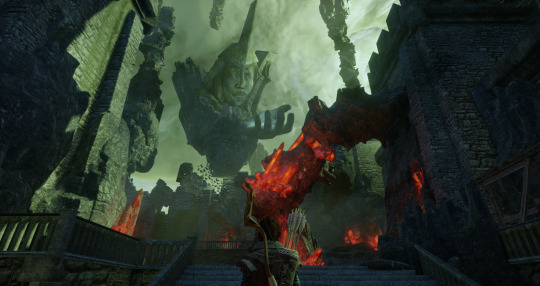
This post has compiled the most relevant information during the main quest for completion’s sake. These quests have little ��archaeological” value, but since I’m visually covering the majority of the game, I can’t put them aside since there are some exceptions, such as the Temple of Mythal.
[This is part of the series “Playing DA like an archaeologist”]

Along the corridors of the Redcliffe Castle, we find andrastian statues such as maferath crying on the sword [1], andraste variations [1], the Man holding bigger head [2], Tevinter diapason-like artefacts [3], and alamarri mabaris clipped with skulls [4,5]
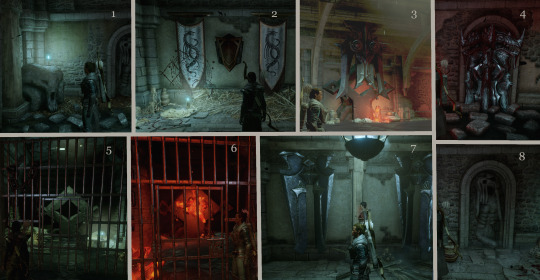
Avvar heads [1], Tevinter banenrs with glyphs [2], strange clipping combinations of different assets to pretend to create a new one [3], sacrificial altars [3,5,6], dragon gargoyles [4], more Tevinter artefacts [7] and classic keepers of fear [8].

More artefacts appear by the end of the castle: upside-down artefact of Temple of Dumat [1], torture devices [2], more avvar heads or Eroded dragon skull [3], Maferath statues and Keepers of Fear [4], Andraste in Ferelden style [5] and Free Marches statues with alamarri mabaris clipped with skulls [6].

I found it curios that this universe is an abomination in Solas’ opinion, so I guess he has in mind something different for the future of Thedas when he destroys the Veil.

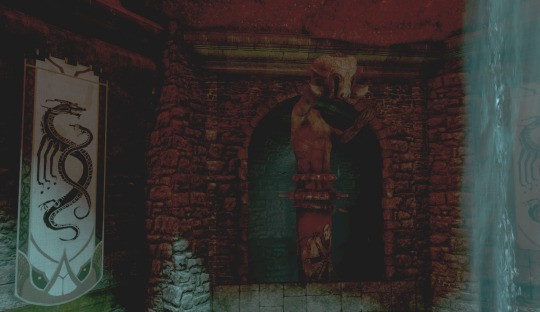
Trying to reach the outside of the castle, we see more of these strange clipped statues and in the darkest corner, we see the unusual statue of Beheaded ram-man.

Some rooms display Andraste iconography of her life and more Ferelden items. In this case, they display Templar rugs. Rugs are something to question, since we keep seeing Inquisition rugs and carpets in places where there is no way they could be there. So in general, my conclusion about rugs is not to pay them too much attention, so maybe I may have done a mistake in Emerald Graves: Din'an Hanin with doing such a extreme analysis over a damned rug, lol.
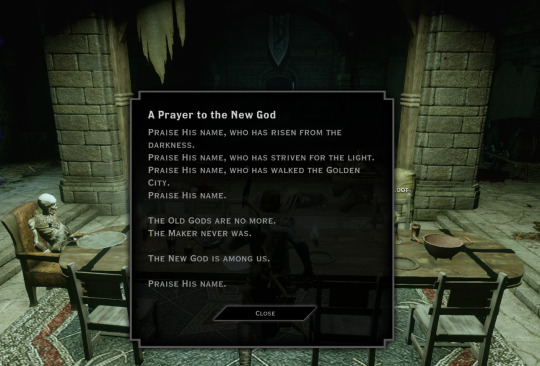
We find the codex A prayer, where we are again suggested to connect darkness with Blight. There is an implication that the Old Gods were gods at some point, but not anymore, and the Maker was always invented. One can suspect this prayer is based on Corypheus’ knowledge shared to his subjects.
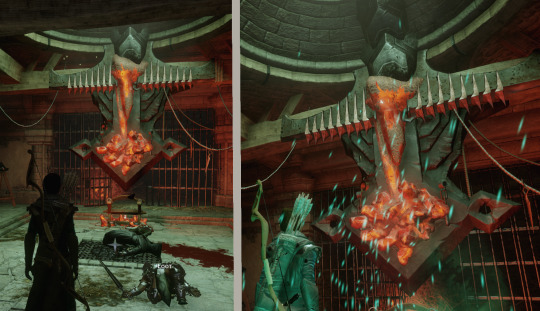
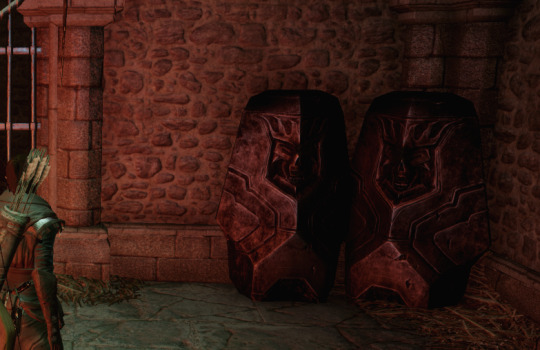
The art of clipping artefacts: diapason-like artefacts in combination with a sacrificial altar and some red lyrium. In this room there are Tevinter urns too.

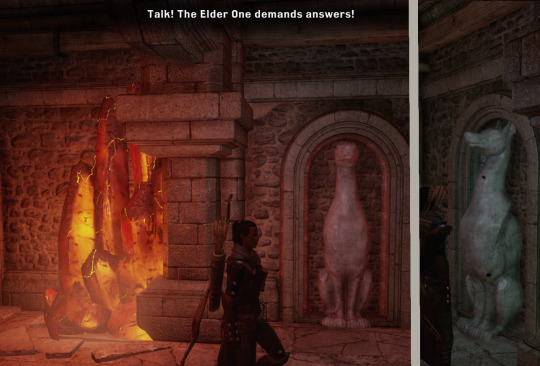
We see again Man holding bigger head statue and two stylised dogs, both Orlesian statues.


Here we find an angry Leliana, changed and transformed due to the torture. We learn she is also immune [or resistant] to Red Lyrium, like Seekers are. This implies lore-wise that Leliana may have been touched by a spirit at some point in her life.
Once more, we have another character in DA series who speaks this line so similar to Flemeth/Myhtal: “I’ve suffered, the whole world suffered. It was real”
Red Lyrium


When we meet Fiona, we see she is half a vein of red lyrium. Later, we see Templar in similar ways along the castle. A creature become a vein of red lyrium just by exposure. This implies that the spread of the Red Lyrium has doom connotations. So far, we don’t know how to rend it inert, and it infects by mere exposure, living creatures as well as objects. It’s a disease even worse than the Blight which can be contained if living creatures are blocked from an area.

We are given several bits of info about the nature of the red lyrium. Dorian question if it’s a disease as the Blight, that only affects living creatures. This red lyrium seems to affect things and objects as well, growing out of them.
Exterior

Now, having the interpretation of this statue of the Faceless figure holding a crown as the Maker, makes this cinematic angle even more dramatic, with a gigantic Andraste, shattered, trying to reach down to the Maker.
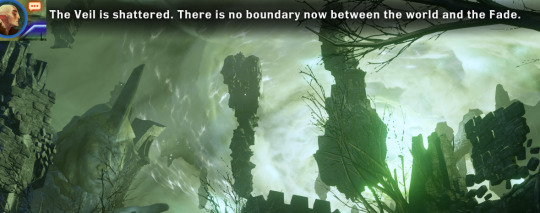

Solas informs us that there is no Veil in this world, so all the non-physical situations we are seeing, the nonsense of the statues in the corridors seem to be justified.
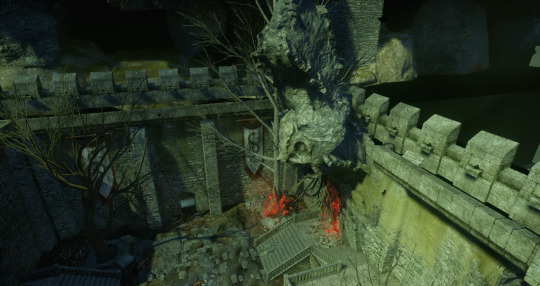
Now without Veil, we make sense of the mixed sculptures we saw in the corridors, reflection and reality overlapping each other. As we go up looking for Alexius, we keep seeing strange statues, like Keepers of fear
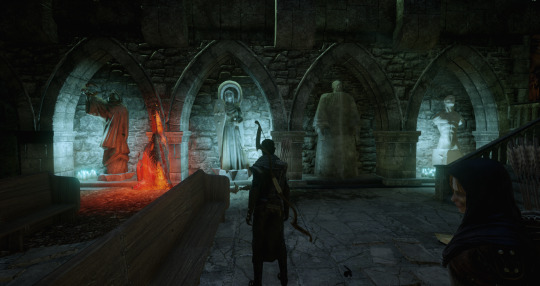
We reach to a place where we can explore more corridors heading to Alexis. This particular set seems to be carefully done to imply something: The Maker with red Lyrium, the Andraste warrior, the Blocky bearded humanoid [which seems to be in the shadows] and this Adonis human statue.
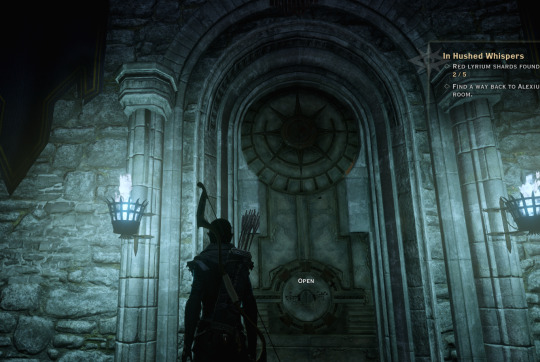
When we reach Alexius’ chamber, we see an Elven Ancient Shard-based door. It’s impossible to know if it was taken from an ancient tomb or its a reflection of the Fade and overlapped with the reality. Curiously, this door requires red lyrium-based shards.
#playing DA like an archaeologist#Tevinter objects#Elven Ancient shard-based door#blocky bearded humanoid#andraste#red lyrium#Faceless figure holding a crown#stylised dogs#Man holding bigger head#Tevinter urns#sacrificial altar#Beheaded ram-man#mabari statues#Eroded dragon skull#Artefact of Temple of Dumat#tevinter design#ferelden design#tevinter artefacts#andrastian design#dragon gargoyles#main quest#Keepers of Fear
9 notes
·
View notes
Text
super niche but.
Queerplatonic retired knights couple and their adopted daughter who'll become a knight herself someday. Also they have a dog who can shoot fireballs out of his,,, uh,,, right. Might need to forget the dog yeah.

#dragon hunters#this movie was my childhood okay#no but the worldbuilding design#flying islands and buildings based off Angkor temples#this whole movie was a fever dream tbh
1 note
·
View note
Text
Fantasy Guide to Interiors



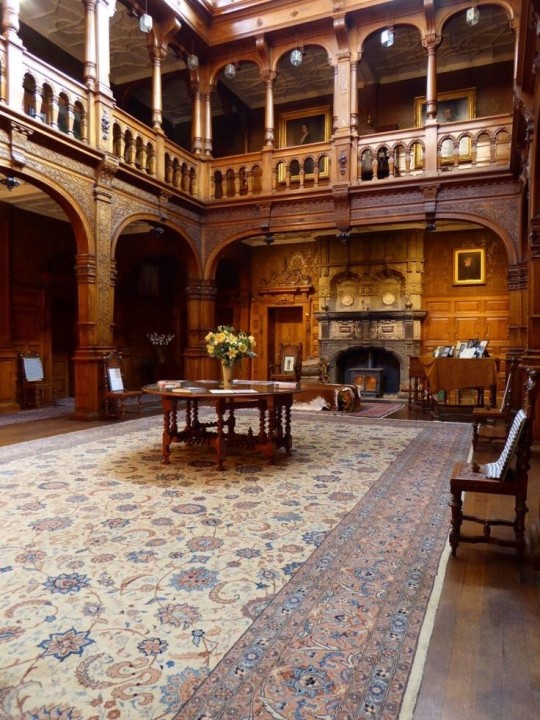
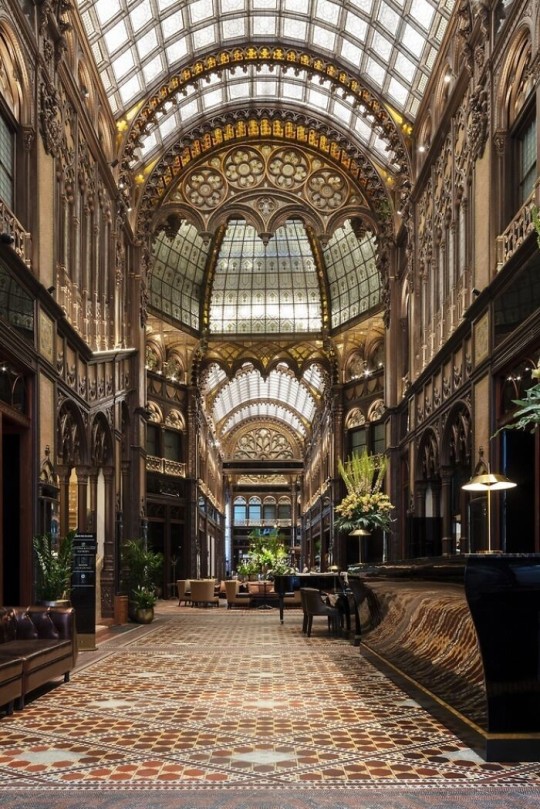
As a followup to the very popular post on architecture, I decided to add onto it by exploring the interior of each movement and the different design techniques and tastes of each era. This post at be helpful for historical fiction, fantasy or just a long read when you're bored.
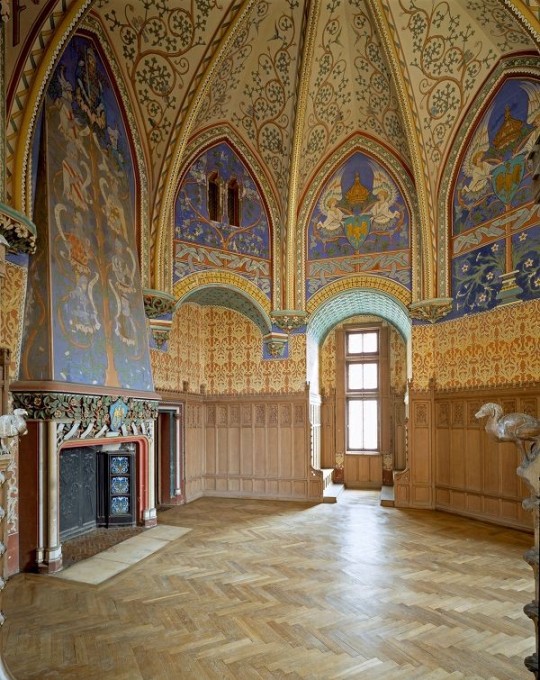


Interior Design Terms
Reeding and fluting: Fluting is a technique that consists a continuous pattern of concave grooves in a flat surface across a surface. Reeding is it's opposite.
Embossing: stamping, carving or moulding a symbol to make it stand out on a surface.
Paneling: Panels of carved wood or fabric a fixed to a wall in a continuous pattern.
Gilding: the use of gold to highlight features.
Glazed Tile: Ceramic or porcelain tiles coated with liquid coloured glass or enamel.
Column: A column is a pillar of stone or wood built to support a ceiling. We will see more of columns later on.
Bay Window: The Bay Window is a window projecting outward from a building.
Frescos: A design element of painting images upon wet plaster.
Mosaic: Mosaics are a design element that involves using pieces of coloured glass and fitted them together upon the floor or wall to form images.
Mouldings: ornate strips of carved wood along the top of a wall.
Wainscoting: paneling along the lower portion of a wall.
Chinoiserie: A European take on East Asian art. Usually seen in wallpaper.
Clerestory: A series of eye-level windows.
Sconces: A light fixture supported on a wall.
Niche: A sunken area within a wall.
Monochromatic: Focusing on a single colour within a scheme.
Ceiling rose: A moulding fashioned on the ceiling in the shape of a rose usually supporting a light fixture.
Baluster: the vertical bars of a railing.
Façade: front portion of a building
Lintel: Top of a door or window.
Portico: a covered structure over a door supported by columns
Eaves: the part of the roof overhanging from the building
Skirting: border around lower length of a wall
Ancient Greece
Houses were made of either sun-dried clay bricks or stone which were painted when they dried. Ground floors were decorated with coloured stones and tiles called Mosaics. Upper level floors were made from wood. Homes were furnished with tapestries and furniture, and in grand homes statues and grand altars would be found. Furniture was very skillfully crafted in Ancient Greece, much attention was paid to the carving and decoration of such things. Of course, Ancient Greece is ancient so I won't be going through all the movements but I will talk a little about columns.
Doric: Doric is the oldest of the orders and some argue it is the simplest. The columns of this style are set close together, without bases and carved with concave curves called flutes. The capitals (the top of the column) are plain often built with a curve at the base called an echinus and are topped by a square at the apex called an abacus. The entablature is marked by frieze of vertical channels/triglyphs. In between the channels would be detail of carved marble. The Parthenon in Athens is your best example of Doric architecture.
Ionic: The Ionic style was used for smaller buildings and the interiors. The columns had twin volutes, scroll-like designs on its capital. Between these scrolls, there was a carved curve known as an egg and in this style the entablature is much narrower and the frieze is thick with carvings. The example of Ionic Architecture is the Temple to Athena Nike at the Athens Acropolis.
Corinthian: The Corinthian style has some similarities with the Ionic order, the bases, entablature and columns almost the same but the capital is more ornate its base, column, and entablature, but its capital is far more ornate, commonly carved with depictions of acanthus leaves. The style was more slender than the others on this list, used less for bearing weight but more for decoration. Corinthian style can be found along the top levels of the Colosseum in Rome.
Tuscan: The Tuscan order shares much with the Doric order, but the columns are un-fluted and smooth. The entablature is far simpler, formed without triglyphs or guttae. The columns are capped with round capitals.
Composite: This style is mixed. It features the volutes of the Ionic order and the capitals of the Corinthian order. The volutes are larger in these columns and often more ornate. The column's capital is rather plain. for the capital, with no consistent differences to that above or below the capital.
Ancient Rome
Rome is well known for its outward architectural styles. However the Romans did know how to add that rizz to the interior. Ceilings were either vaulted or made from exploded beams that could be painted. The Romans were big into design. Moasics were a common interior sight, the use of little pieces of coloured glass or stone to create a larger image. Frescoes were used to add colour to the home, depicting mythical figures and beasts and also different textures such as stonework or brick. The Romans loved their furniture. Dining tables were low and the Romans ate on couches. Weaving was a popular pastime so there would be tapestries and wall hangings in the house. Rich households could even afford to import fine rugs from across the Empire. Glass was also a feature in Roman interior but windows were usually not paned as large panes were hard to make. Doors were usually treated with panels that were carved or in lain with bronze.
Ancient Egypt
Egypt was one of the first great civilisations, known for its immense and grand structures. Wealthy Egyptians had grand homes. The walls were painted or plastered usually with bright colours and hues. The Egyptians are cool because they mapped out their buildings in such a way to adhere to astrological movements meaning on special days if the calendar the temple or monuments were in the right place always. The columns of Egyptian where thicker, more bulbous and often had capitals shaped like bundles of papyrus reeds. Woven mats and tapestries were popular decor. Motifs from the river such as palms, papyrus and reeds were popular symbols used.
Ancient Africa
African Architecture is a very mixed bag and more structurally different and impressive than Hollywood would have you believe. Far beyond the common depictions of primitive buildings, the African nations were among the giants of their time in architecture, no style quite the same as the last but just as breathtaking.
Rwandan Architecture: The Rwandans commonly built of hardened clay with thatched roofs of dried grass or reeds. Mats of woven reeds carpeted the floors of royal abodes. These residences folded about a large public area known as a karubanda and were often so large that they became almost like a maze, connecting different chambers/huts of all kinds of uses be they residential or for other purposes.
Ashanti Architecture: The Ashanti style can be found in present day Ghana. The style incorporates walls of plaster formed of mud and designed with bright paint and buildings with a courtyard at the heart, not unlike another examples on this post. The Ashanti also formed their buildings of the favourite method of wattle and daub.
Nubian Architecture: Nubia, in modern day Ethiopia, was home to the Nubians who were one of the world's most impressive architects at the beginning of the architecture world and probably would be more talked about if it weren't for the Egyptians building monuments only up the road. The Nubians were famous for building the speos, tall tower-like spires carved of stone. The Nubians used a variety of materials and skills to build, for example wattle and daub and mudbrick. The Kingdom of Kush, the people who took over the Nubian Empire was a fan of Egyptian works even if they didn't like them very much. The Kushites began building pyramid-like structures such at the sight of Gebel Barkal
Japanese Interiors
Japenese interior design rests upon 7 principles. Kanso (簡素)- Simplicity, Fukinsei (不均整)- Asymmetry, Shizen (自然)- Natural, Shibumi (渋味) – Simple beauty, Yugen (幽玄)- subtle grace, Datsuzoku (脱俗) – freedom from habitual behaviour, Seijaku (静寂)- tranquillity.
Common features of Japanese Interior Design:
Shoji walls: these are the screens you think of when you think of the traditional Japanese homes. They are made of wooden frames, rice paper and used to partition
Tatami: Tatami mats are used within Japanese households to blanket the floors. They were made of rice straw and rush straw, laid down to cushion the floor.
Genkan: The Genkan was a sunken space between the front door and the rest of the house. This area is meant to separate the home from the outside and is where shoes are discarded before entering.
Japanese furniture: often lowest, close to the ground. These include tables and chairs but often tanked are replaced by zabuton, large cushions. Furniture is usually carved of wood in a minimalist design.
Nature: As both the Shinto and Buddhist beliefs are great influences upon architecture, there is a strong presence of nature with the architecture. Wood is used for this reason and natural light is prevalent with in the home. The orientation is meant to reflect the best view of the world.
Islamic World Interior
The Islamic world has one of the most beautiful and impressive interior design styles across the world. Colour and detail are absolute staples in the movement. Windows are usually not paned with glass but covered in ornate lattices known as jali. The jali give ventilation, light and privacy to the home. Islamic Interiors are ornate and colourful, using coloured ceramic tiles. The upper parts of walls and ceilings are usually flat decorated with arabesques (foliate ornamentation), while the lower wall areas were usually tiled. Features such as honeycombed ceilings, horseshoe arches, stalactite-fringed arches and stalactite vaults (Muqarnas) are prevalent among many famous Islamic buildings such as the Alhambra and the Blue Mosque.
Byzantine (330/395–1453 A. D)
The Byzantine Empire or Eastern Roman Empire was where eat met west, leading to a melting pot of different interior designs based on early Christian styles and Persian influences. Mosaics are probably what you think of when you think of the Byzantine Empire. Ivory was also a popular feature in the Interiors, with carved ivory or the use of it in inlay. The use of gold as a decorative feature usually by way of repoussé (decorating metals by hammering in the design from the backside of the metal). Fabrics from Persia, heavily embroidered and intricately woven along with silks from afar a field as China, would also be used to upholster furniture or be used as wall hangings. The Byzantines favoured natural light, usually from the use of copolas.
Indian Interiors
India is of course, the font of all intricate designs. India's history is sectioned into many eras but we will focus on a few to give you an idea of prevalent techniques and tastes.
The Gupta Empire (320 – 650 CE): The Gupta era was a time of stone carving. As impressive as the outside of these buildings are, the Interiors are just as amazing. Gupta era buildings featured many details such as ogee (circular or horseshoe arch), gavaksha/chandrashala (the motif centred these arches), ashlar masonry (built of squared stone blocks) with ceilings of plain, flat slabs of stone.
Delhi Sultanate (1206–1526): Another period of beautifully carved stone. The Delhi sultanate had influence from the Islamic world, with heavy uses of mosaics, brackets, intricate mouldings, columns and and hypostyle halls.
Mughal Empire (1526–1857): Stonework was also important on the Mughal Empire. Intricately carved stonework was seen in the pillars, low relief panels depicting nature images and jalis (marble screens). Stonework was also decorated in a stye known as pietra dura/parchin kari with inscriptions and geometric designs using colored stones to create images. Tilework was also popular during this period. Moasic tiles were cut and fitted together to create larger patters while cuerda seca tiles were coloured tiles outlined with black.
Chinese Interiors
Common features of Chinese Interiors
Use of Colours: Colour in Chinese Interior is usually vibrant and bold. Red and Black are are traditional colours, meant to bring luck, happiness, power, knowledge and stability to the household.
Latticework: Lattices are a staple in Chinese interiors most often seen on shutters, screens, doors of cabinets snf even traditional beds.
Lacquer: Multiple coats of lacquer are applied to furniture or cabinets (now walls) and then carved. The skill is called Diaoqi (雕漆).
Decorative Screens: Screens are used to partition off part of a room. They are usually of carved wood, pained with very intricate murals.
Shrines: Spaces were reserved on the home to honour ancestors, usually consisting of an altar where offerings could be made.
Of course, Chinese Interiors are not all the same through the different eras. While some details and techniques were interchangeable through different dynasties, usually a dynasty had a notable style or deviation. These aren't all the dynasties of course but a few interesting examples.
Song Dynasty (960–1279): The Song Dynasty is known for its stonework. Sculpture was an important part of Song Dynasty interior. It was in this period than brick and stone work became the most used material. The Song Dynasty was also known for its very intricate attention to detail, paintings, and used tiles.
Ming Dynasty(1368–1644): Ceilings were adorned with cloisons usually featuring yellow reed work. The floors would be of flagstones usually of deep tones, mostly black. The Ming Dynasty favoured richly coloured silk hangings, tapestries and furnishings. Furniture was usually carved of darker woods, arrayed in a certain way to bring peace to the dwelling.
Han Dynasty (206 BC-220 AD): Interior walls were plastered and painted to show important figures and scenes. Lacquer, though it was discovered earlier, came into greater prominence with better skill in this era.
Tang Dynasty (618–907) : The colour palette is restrained, reserved. But the Tang dynasty is not without it's beauty. Earthenware reached it's peak in this era, many homes would display fine examples as well. The Tang dynasty is famous for its upturned eaves, the ceilings supported by timber columns mounted with metal or stone bases. Glazed tiles were popular in this era, either a fixed to the roof or decorating a screen wall.
Romanesque (6th -11th century/12th)
Romanesque Architecture is a span between the end of Roman Empire to the Gothic style. Taking inspiration from the Roman and Byzantine Empires, the Romanesque period incorporates many of the styles. The most common details are carved floral and foliage symbols with the stonework of the Romanesque buildings. Cable mouldings or twisted rope-like carvings would have framed doorways. As per the name, Romansque Interiors relied heavily on its love and admiration for Rome. The Romanesque style uses geometric shapes as statements using curves, circles snf arches. The colours would be clean and warm, focusing on minimal ornamentation.
Gothic Architecture (12th Century - 16th Century)
The Gothic style is what you think of when you think of old European cathedrals and probably one of the beautiful of the styles on this list and one of most recognisable. The Gothic style is a dramatic, opposing sight and one of the easiest to describe. Decoration in this era became more ornate, stonework began to sport carving and modelling in a way it did not before. The ceilings moved away from barreled vaults to quadripartite and sexpartite vaulting. Columns slimmed as other supportive structures were invented. Intricate stained glass windows began their popularity here. In Gothic structures, everything is very symmetrical and even.
Mediaeval (500 AD to 1500)
Interiors of mediaeval homes are not quite as drab as Hollywood likes to make out. Building materials may be hidden by plaster in rich homes, sometimes even painted. Floors were either dirt strewn with rushes or flagstones in larger homes. Stonework was popular, especially around fireplaces. Grand homes would be decorated with intricate woodwork, carved heraldic beasts and wall hangings of fine fabrics.
Renaissance (late 1300s-1600s)
The Renaissance was a period of great artistry and splendor. The revival of old styles injected symmetry and colour into the homes. Frescoes were back. Painted mouldings adorned the ceilings and walls. Furniture became more ornate, fixed with luxurious upholstery and fine carvings. Caryatids (pillars in the shape of women), grotesques, Roman and Greek images were used to spruce up the place. Floors began to become more intricate, with coloured stone and marble. Modelled stucco, sgraffiti arabesques (made by cutting lines through a layer of plaster or stucco to reveal an underlayer), and fine wall painting were used in brilliant combinations in the early part of the 16th century.
Tudor Interior (1485-1603)
The Tudor period is a starkly unique style within England and very recognisable. Windows were fixed with lattice work, usually casement. Stained glass was also in in this period, usually depicting figures and heraldic beasts. Rooms would be panelled with wood or plastered. Walls would be adorned with tapestries or embroidered hangings. Windows and furniture would be furnished with fine fabrics such as brocade. Floors would typically be of wood, sometimes strewn with rush matting mixed with fresh herbs and flowers to freshen the room.
Baroque (1600 to 1750)
The Baroque period was a time for splendor and for splashing the cash. The interior of a baroque room was usually intricate, usually of a light palette, featuring a very high ceiling heavy with detail. Furniture would choke the room, ornately carved and stitched with very high quality fabrics. The rooms would be full of art not limited to just paintings but also sculptures of marble or bronze, large intricate mirrors, moldings along the walls which may be heavily gilded, chandeliers and detailed paneling.
Victorian (1837-1901)
We think of the interiors of Victorian homes as dowdy and dark but that isn't true. The Victorians favoured tapestries, intricate rugs, decorated wallpaper, exquisitely furniture, and surprisingly, bright colour. Dyes were more widely available to people of all stations and the Victorians did not want for colour. Patterns and details were usually nature inspired, usually floral or vines. Walls could also be painted to mimic a building material such as wood or marble and most likely painted in rich tones. The Victorians were suckers for furniture, preferring them grandly carved with fine fabric usually embroidered or buttoned. And they did not believe in minimalism. If you could fit another piece of furniture in a room, it was going in there. Floors were almost eclusively wood laid with the previously mentioned rugs. But the Victorians did enjoy tiled floors but restricted them to entrances. The Victorians were quite in touch with their green thumbs so expect a lot of flowers and greenery inside. with various elaborately decorated patterned rugs. And remember, the Victorians loved to display as much wealth as they could. Every shelf, cabinet, case and ledge would be chocked full of ornaments and antiques.
Edwardian/The Gilded Age/Belle Epoque (1880s-1914)
This period (I've lumped them together for simplicity) began to move away from the deep tones and ornate patterns of the Victorian period. Colour became more neutral. Nature still had a place in design. Stained glass began to become popular, especially on lampshades and light fixtures. Embossing started to gain popularity and tile work began to expand from the entrance halls to other parts of the house. Furniture began to move away from dark wood, some families favouring breathable woods like wicker. The rooms would be less cluttered.
Art Deco (1920s-1930s)
The 1920s was a time of buzz and change. Gone were the refined tastes of the pre-war era and now the wow factor was in. Walls were smoother, buildings were sharper and more jagged, doorways and windows were decorated with reeding and fluting. Pastels were in, as was the heavy use of black and white, along with gold. Mirrors and glass were in, injecting light into rooms. Gold, silver, steel and chrome were used in furnishings and decor. Geometric shapes were a favourite design choice. Again, high quality and bold fabrics were used such as animal skins or colourful velvet. It was all a rejection of the Art Noveau movement, away from nature focusing on the man made.
Modernism (1930 - 1965)
Modernism came after the Art Deco movement. Fuss and feathers were out the door and now, practicality was in. Materials used are shown as they are, wood is not painted, metal is not coated. Bright colours were acceptable but neutral palettes were favoured. Interiors were open and favoured large windows. Furniture was practical, for use rather than the ornamentation, featuring plain details of any and geometric shapes. Away from Art Deco, everything is straight, linear and streamlined.
#This took forever#I'm very tired#But enjoy#I covered as much as I could find#Fantasy Guide to interiors#interior design#Architecture#writings#writing resources#Writing reference#Writing advice#Writer's research#writing research#Writer's rescources#Writing help#Mediaeval#Renaissance#Chinese Interiors#Japanese Interiors#Indian interiors#writing#writeblr#writing reference#writing advice#writer#spilled words#writers
3K notes
·
View notes
Text
Some Architecture Vocabulary

Arcade: a succession of arches supported on columns. An arcade can be free-standing covered passage or attached to a wall, as seen on the right.
Arch: the curved support of a building or doorway. The tops of the arches can be curved, semicircular, pointed, etc.
Architrave: the lowest part of the entablature that sits directly on the capitals (tops) of the columns.
Capital: the top portion of a column. In classical architecture, the
architectural order is usually identified by design of the capital (Doric, Ionic, or Corinthian).
Classical: of or pertaining to Classicism.
Classicism: a preference or regard for the principles of Greek and Roman art and architecture. Common classicizing architecture is a sense of balance, proportion, and “ideal” beauty.
Column: an upright post, usually square, round, or rectangular. It can be used as a support or attached to a wall for decoration. In classical architecture, columns are composed of a capital, shaft, and a base (except in the Doric order).
Cornice: the rectangular band above the frieze, below the pediment.
Dome: a half-sphere curvature constructed on a circular base, as seen on the right.
Entablature: the upper portion of an order, it includes the
architrave, frieze and cornice.
Frieze: the wide rectangular section on the entablature, above the architrave and below the cornice. In the Doric order, the frieze is often decorated with triglyphs (altering tablets of vertical groves) and the plain, rectangular bands spaced between the triglyphs (called metopes).
Metopes: the rectangular slabs that adorned the outside of Doric temples, just above the exterior colonnade.
Order: an ancient style of architecture. The classical orders are Doric, Ionic, or Corinthian. An order consists of a column, with a distinctive capital, supporting the entablature and pediment.
Pediment: a classical element that forms a triangular shape above the entablature. The pediment is often decorated with statues and its sides can be curved or straight.
Pronaos (pro-NAY-us): the entrance hall of a temple.
Triglyphs: a decorative element of a frieze consisting of three vertical units.
Vault: an arched ceiling usually made of wood or stone, as seen on the right.
More: Word Lists
#writeblr#writing notes#terminology#writers on tumblr#architecture#writing prompt#poetry#literature#poets on tumblr#spilled ink#creative writing#writing reference#dark academia#light academia#lit#worldbuilding#studyblr#langblr#booklr#bookblr#word list#writing resources
568 notes
·
View notes
Text
god i feel rough (failing delusionship) so let's do a quick little reaction to giving the 141 little gifts
you and soap regularly sit around and watch your favorite movies. gives you guys something extra to talk about while out in the field. most of them military related like American sniper or some really stupid comedies like the Hangover. A long time favorite of both of yours is the Office, though. So when you're on leave and see one of those stupid Dunder Mifflin keychains, you don't even think twice about getting it for him. When you're back and give it to him, Johnny gets real quiet and puts it on his keys. Gives you a little kiss to your temple and turns on one of your favorite episodes. Keeps you in his arms for awhile after that, platonically of course, bonnie.
ghost and you don't really talk much. you're both together a lot though, existing in each other's orbit. he does paperwork, cleans his guns, stitches up a new mask, whatever. you work on a new hobby, watch YouTube, sleep, or yap into the void. nevertheless, you two are very close. imagine simon's surprise one day as you two sit, your back against his shoulder, as you finish up a friendship bracelet for him. intricate little heart design. you hold it out to him in offering with a little smile, a bit too cautious for his taste. holds his wrist out, lets you put it on him. doesn't say much, but notices you made yourself a matching one. takes it, puts it on your wrist, and brings it to where his mouth is under his mask. little peck. best gift he's ever gotten, birdie. goes back to his work, but it becomes his fidget toy. inspects your wrist when he sees you without yours, brows furrowed. follows you around like a little lost puppy until you confirm that yes, simon, everything's fine.
gaz is baby. he loves spending time with you around base. your room is next to his, making it is easy for you two to meet up and have a nice time. however, his time in the military has made him harder and more forgetful to civilian celebrations and traditions. so when you two are sitting on night watch and you pull out a little cake with happy birthday gaz written on it, he remembers fond memories of a time before. loves you for bringing good memories to his forefront. shares with you, feeding you with his fork. pinkies linked as you watch the sunrise.
gruff old man price won't accept much. he's got a lot on his plate, doesn't need much else going on around him. however, when his favorite little sergeant stops by with a little treat and a cigar for him, he's gooey. all pleasant smiles, wonderful manners, asking about your day. hides his emotions when you mention a pesky little flea on another squad has been bothering you. don't worry, darling, you don't know it but he'll take care of it (if one of his boys doesn't first).
they'd be jealous of eachothers attention on you if they didn't feel the exact same way. pretty little thing, only for them.
#taskforce 141 x reader#task force 141#call of duty x reader#ghost x reader#john soap mactavish x reader#johnny mactavish x reader#simon ghost riley x you#simon ghost riley x reader#simon ghost riley#john price x reader#simon riley x you#cod headcanons#kyle gaz garrick x you#kyle gaz garrick x reader#kyle garrick x fem!reader#kyle garrick#taskforce 141 headcanons#john price#john price x you#ghost cod
674 notes
·
View notes
Text

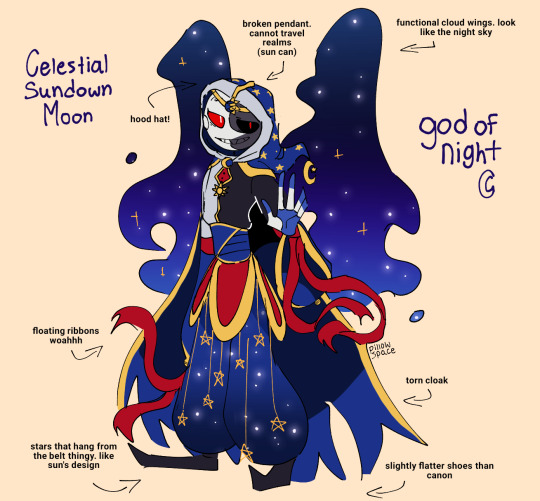
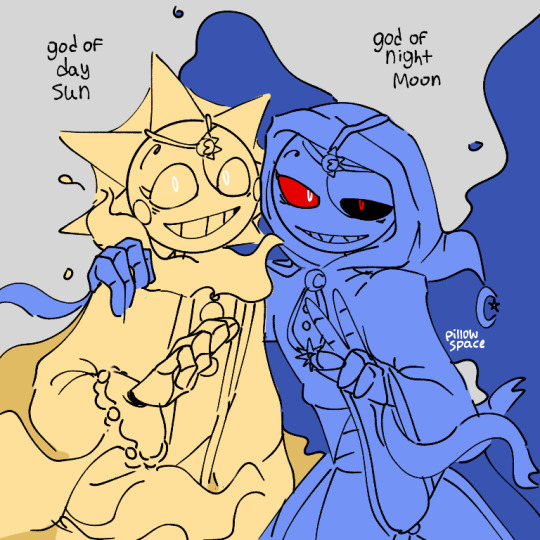
Celestial Sundown AU Moon
He is the god of night, and a guardian to children. This AU is based on a dream I had awhile back. I've finally DESIGNED him !!! I can rest easy now
Sun, god of day
(NOTE: spoilers ahead for people coming from the fic)
---
After multiple children were sacrificed in his name for the request of aid (the interpretations of Sun and Moon vary from culture to culture, so in that particular culture, Moon was more known for having a detached liking rather than protectiveness), Moon slaughtered the entire town responsible, a town which had temples for varying gods and, therefore, held favour from the Celestial Realm. It was his final strike, and his right to travel to the Mortal Realm was officially revoked.
(You found the town's frightening aftermath while passing through when you were younger, but you and Moon did not cross paths.)
Moon now solely resides in the Celestial Realm, where Sun keeps him company and frequently brings him trinkets from the Mortal Realm to keep him from getting bored. Though while it mildly helps, Moon still feels aimless with his guardian role now obsolete.
Moon can turn any music he plays hypnotic, but the trance is not unbreakable. He can also blend into any dark space he wants by wrapping his clouds around himself. Both Moon and Sun can dismiss their clouds at will.
#pillowspace art#celestial sundown au#dca au#moondrop#fnaf moon#fnaf daycare attendant#moon fnaf#fnafsb#fnaf security breach#fnaf au#fnaf sun#sundrop#sun fnaf#artfave#[csd art tag]
3K notes
·
View notes
Text
Shopping Trip
Pairing: Lando Norris x Hispanic/Latina! Reader
Summary: Lando and Y/N go to the mall and Lando is bored
Warning: Spelling and grammatical errors
A/N: based the scene from the Barbie Movie, you know the one.

Lando was in Monaco, came home after the triple header and like most drivers, he missed his girlfriend. Lando was asleep in his bed when he heard Y/N getting dressed.
“What are you doing up, sweet thing? I thought we could stay in bed.” Lando said.
“Mm, I would love to, mi fresita, but I can’t. I have a nail appointment at the galleria.” Y/N said.
“You mean the metropole shopping center?” Lando asked.
“It’s a big indoor mall, I’m calling it a galleria. I’ll probably have a look around too.” Y/N said.
“Can I come with you?” Lando asked.
“You wanna come with me to get my nails done?” Y/N asked.
“Yeah, I could pick out your nail color, I’m paying. Let me shower real quick and we can go.” Lando said.
“Okay, amor.” Y/N said. Y/N had a quick snack and looked for Pinterest photos of nail designs while she waited for Lando to shower and get dressed. Once dressed, Lando got out of the room and sat next to Y/N. “Great, pick which design you like.” Lando took Y/N’s phone and searched through her Pinterest board until he landed on a design he liked.
“This one is very you. Plus, it’s cute and girly, and the color suits you, you ready to go?” Lando asked. Y/N nodded and both of them left the apartment to go to his car.
Though the rules are ‘driver picks the music, shotgun shuts their cakehole’, Lando let Y/N pick the music. Once they arrived at the mall, Lando opened Y/N’s door to let her out and they walked into the mall, some people were asking for photos on their way to the nail salon. Y/N walked in first.
“Hello, I’m Y/N, I have an appointment.” Y/N said.
“Ah yes, we were expecting you, we have your chair ready right here.” The employee lead Y/N to the ‘nail station’ while Lando sat in the waiting area. As soon as Y/N was settled, they began their work, using the nail drill to buff her nails. The acrylic isn’t even on Y/N’s nail when Lando decided to stand next to her.
“Darling, I’m bored.” Lando said with a pout, Y/N turned her head.
“Cariño, you wanted to come with me. Just entertain yourself, find something to do.” Y/N said, turning her head back to make conversation with the nail tech. Lando looked around the nail salon.
“What am I supposed to do?” Lando asked.
“Lando! Go for a walk or something.” Y/N said
“By myself?” Lando asked.
“Yes!” Y/N exclaimed.
“Where?” Lando asked.
“Anywhere!” Y/N exclaimed.
“Can i go that way?” Lando asked, pointing to a store across the nail salon.
“Yes.” Y/N said. Lando started walking but he didn’t leave the salon yet. “Don’t go too far.” Y/N said.
“Okay!” Lando exclaimed. He walked back to where Y/N was sitting. “I’ll text you what store I’m at, here’s a couple hundred bucks, I love you.” Lando said, kissing her temple, adding the couple hundred bucks in her bag.
“I love you too, stay on the first floor please.” Y/N said.
“I will.” Lando said before leaving.
An hour or so later, Y/N’s nails are finished, she paid the nail tech, and checked her phone to see what store Lando is at but she found him sitting by the water fountain, eating chicken wings.
“You got food?” Y/N asked.
“I was hungry and I came here to spend time with you, which means we will check the stores together. Let me see your nails.” Lando said and Y/N showed him her nails.

“Beautiful, they did a great job. Maybe when it’s time for me to propose, I’ll send you here to get your nails done.” Lando said, getting up from the fountain edge to walk with Y/N,
“Wow, you think about proposing to me?” Y/N asked.
“Of course I do, you’re the best thing that’s ever happened to me, I plan on spending the rest of my life with you.” Lando said,
“You are the sweetest. Think we can go to Sephora?” Y/N asked.
“You spend too much money at Sephora.” Lando said,
“It’s not my fault Ulta isn’t available in Europe. Which is stupid, by the way, Sephora is so expensive for no reason, they don’t have my favorite shampoo and conditioner.” Y/N said.
“All right, let’s go to Sephora.” Lando said.
“Yay!” Y/N said.
The End
Hope y’all liked it, short but cute, do you think Lando would be like this?
#hispanic reader#latina#hispanic#f1 x reader#f1 imagine#f1 fanfic#lando norris fluff#lando norris imagine#lando norris x reader#lando norris
431 notes
·
View notes
Text
thinking about.. best friend!satoru gojo who immediately answers when you come calling
bestie!gojo who not-so-secretly, secretly has feelings for you
bestie!gojo who knows everything there is to know about you. Your oh-so wonderful taste in partners… Your likes and dislikes, hobbies, career plans, plans for the future.. anything and everything. Even if you do or don’t exactly tell him
bestie!gojo who drops everything that he’s doing to come see you, when hearing your incoherent sentences of something along the lines of, “…. dumped boyfriend… cheated..”
bestie!gojo who comforts you in your time of need. Listening to all your rants about your ex-boyfriend, supplying you with whatever he thinks would cheer you up, offering you comforting words instead of solutions.
What a great best friend to have!! Right..?

“I hate him so much! What a no good bitch ass womanizer!!” You exclaimed in a fit of rage, scrolling through the posts of the woman who, your ex cheated on you with, as satoru tiredly sighs.
“What does she have that I don’t-“ and before you could continue on, you get cut off by your best friend, Satoru. “Absolutely nothing, sweetheart. You should know your worth by now. It’s not something you have or ‘don’t have,’ it’s the simple minded mentality of… What’s his name again?— Doesn’t matter, He’s too simple minded to know the true worth of what he has in front of him.” He tangibly states, as if it was the most well-known fact in the world.
You attempted to up at him through your clouded vision, blinking away tears that spilled like waterfalls. Taking glances between Satoru, and the images on your phone, you stay silent as he studies you, pools of cool colored diamond eyes staring into yours, hoping to see any slight change of positivity.
He sighs again, taking a seat on your bed as he snatches your phone away from you, and before you could protest, he cuts you off once again… by pulling you close, into a hug. Instinctively, you wrap your arms around him, as you let out all your pent up feelings. Sobbing into his chest, as he soothes circles into your back, not caring that you mess up whatever designer shirt he’s wearing.
Satoru’s heart breaks hearing you hurt, he wants nothing more than to ruin whoever was the cause of your problems. But right now, he’s more focused on you.
Satoru hushes your cries, wiping away the salty crystalline off your face as he speaks up, “Oh baby, don’t waste your tears on him. He has no idea what he’s missing out on. Don’t waste your energy on a leech that only takes from you, and never gives. Your deserve someone who reciprocates your feelings, and so much more.” He admitted in a dulcet tone, giving feathery caresses to the side of your face, as he placed a sparse kiss to the side of your temple.
“Cheer up, theses plenty of people who would give the world and die for your affection.” He states in a much more cheerful and playful tone, making you laugh in response to his exaggerated claim.
…
best friend! Satoru who stays with you, through the night. Comforting and creating a much more positive atmosphere to the contrasted gloomy mood
best friend! Satoru who maybe, you don’t see as just a friend anymore..?

A/N: Whats goody gangy. ☝🏾🤓 Sorry I was gone for 5 months I was going thru it with some bitch ass nigga I dumped, which is kinda what I based this fic off of, except no boy bsf I’m in love with to comfort me.💔 He made me delete tumblr so I couldn’t write 😞 I still kept on reading tho 😈
Not proof read btw, bc I’m high as a mf, writing with dyslexia. And it’s late a night, idk if it’s gonna be late when I post this tho😛
If y’all sent a request, resend it plssss. 🙏🏾 I need inspo mookies, and if you have a request feel free to send one in. Msg me abt wtv, and lmk if I can improve on anything
Thanks lovies take care and, hope y’all enjoyed!! 🩷
-bxnnybimbeax
#jujutsu kaisen#gojo satoru#satoru gojo#jjk satoru#gojo jjk#jjk gojo#jujitsu kaisen gojo#jjk oneshot#jujutsu kaisen satoru#jjk fluff#jjk headcanons#gojo x reader#satoru x you#gojo x you#satoru x reader#reqs open#gojo satoru x reader#gojo satoru x you
741 notes
·
View notes
Text
The Architecture of Rain World: Layers of History
A major theme in Rain World's world design that often goes overlooked is the theme of, as James Primate, the level designer, composer and writer calls it, "Layers of History." This is about how the places in the game feel lived-in, and as though they have been built over each other. Here's what he said on the matter as far back as 2014!

The best example of this is Subterranean, the final area of the base game and a climax of the theme. Subterranean is pretty cleanly slpit vertically, there's the modern subway built over the ancient ruins, which are themselves built over the primordial ruins of the depths. Piercing through these layers is Filtration System, a high tech intrusion that cuts through the ground and visibly drills through the ceiling of the depths.
Two Sprouts, Twelve Brackets, the friendly local ghost, tells the player of the "bones of forgotten civilisations, heaped like so many sticks," highlighting this theme of layering as one of the first impressions the player gets of Subterranean. Barely minutes later, the player enters the room SB_H02, where the modern train lines crumble away into a cavern filled with older ruins, which themselves are invaded by the head machines seen prior in outskirts and farm arrays, some of which appear to have been installed destructively into the ruins, some breaking through floors.
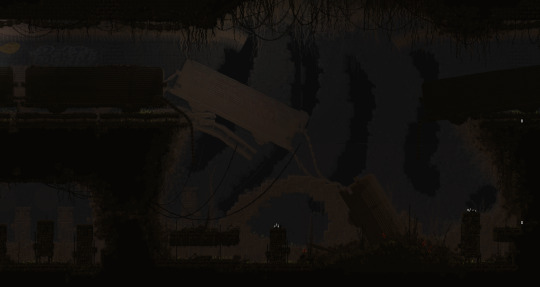
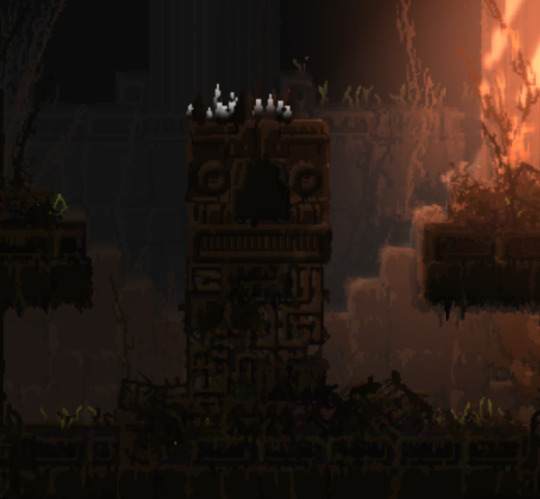
These layers flow into each other, highlighting each other's decrepit state.
The filtration system, most likely the latest "layer," is always set apart from the spaces around it. At its top, the train tunnels give way to a vast chasm, where filtration system stands as a tower over the trains, while at the bottom in depths, it penetrates the ceiling of the temple, a destructive presence. (it's also a parallel to the way the leg does something similar in memory crypts, subterranean is full of callbacks like that!)


Filtration system is an interesting kind of transition, in that it is much later and more advanced than both of the areas it cuts between. This is a really interesting choice from James! It would be more "natural" to transition smoothly from the caves of upper subterranean to the depths, but by putting filtration system in between, the two are clearly demarcated as separate. The difference in era becomes palpable, the player has truly found something different and strange.
Depths itself is, obviously, the oldest layer not only of subterranean but of the game itself. The architecture of Depths has little to do with the rest of the game around it, it's a clear sign of the forgotten civilisations that our friend Two Sprouts, Twelve Brackets showed us, there's not actually that much to say about it itself, it's mostly about how it interacts with the other layers of subterranean.
That said, Subterranean is far from the only case of the theme of layers of history. It's present as soon as the player starts the game!
The very first room of the game, SU_C04, is seemingly a cave. It is below the surface, the shapes of it are distinctly amorphous rather than geometric. (well. kind of, it doesn't do a very good job of hiding the tile grid with its 45 degree angles.)

But let's take a closer look, shall we?

See that ground? it's made of bricks. The entire cave area of outskirts is characterised by this, the "chaotic stone" masonry asset is mixed with brickwork, unlike the surface ruins which are mostly stone. This, seemingly, is an inversion of common sense! The caves are bricks and the buildings are stone. This is not, however, a strange and unique aspect but a recurring motif.
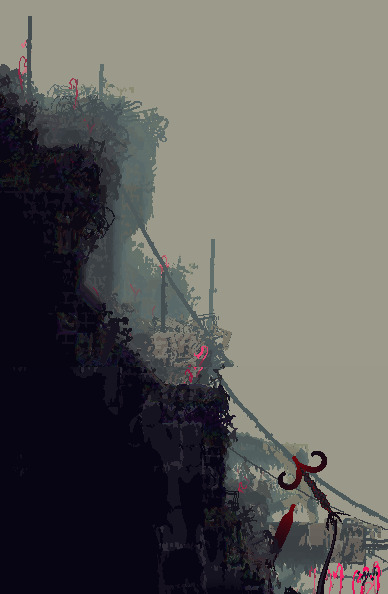
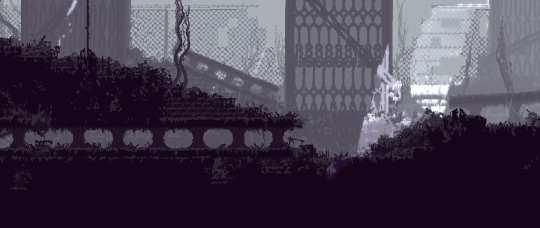
This occurs enough in the game for it to be clearly intentional, but why would materials such as bricks be used in otherwise natural looking terrain?
The answer lies in the "Layers of History" theme. This is in fact, something that happens in real life, and it's called a tell
To be specific, a tell is a kind of mound formed by settlements building over the ruins of previous iterations of themselves. Centuries of rubble and detritus form until a hill grows from the city. Cities such as Troy and Jericho are famous examples. The connections to the layers of history theme are pretty clear here, I think. Cities growing, then dying, then becoming the bedrock of the next city. The ground, then, is made of bricks, because the ground is the rubble of past buildings. The bones of forgotten civilisations, heaped like so many sticks!
#rain world#rainworld#rain world lore#rainworld lore#rw lore#rw#subterranean my beloved#thank you to videocult for making the first survival game themed around stratigraphy and new york city rats#i would've gone on for another paragraph about how OE relates to this but like.#that's dlc stuff#and i still think of the dlc stuff as modded content lol#better to keep it separate#also this analysis is not comprehensive! the layers of history stuff is common throughout#there's farm arrays there's the relationship between shaded citadel and five pebbles there's the stuff buried under garbage wastes#so much more#unfortunately i do not have much energy lol
826 notes
·
View notes
Text
Anew.

includes— hawks x reader. angst. hurt/comfort. minors dni.
warnings— gn!reader. loss of wings and regrowth. nightmares. keigo tends to your wounds. blood description.
You lose your wings for the first time. It does not feel like the first time, but Keigo is there to patch your wounds. Keigo is always there to patch your wounds.

Keigo knew a thing or two about sprouting new feathers from the flesh of one's back. The splintering of new appendages, raw and awakened for the first time like freshly-birthed infants from the womb.
He cared for your seraphic wings. Preened them like his own quirk, cleaned them as if they were sewn to his own back.
Taught you how to care for them, too.
Taught you for the first time the truth, that they grow back. Soothed your worries that they never would.
Taught you how the ache means it's working. Means there's feathers bubbling anew, waiting to burst forth from the flesh.
Keigo sat with you in the living room at three in the morning. You had screamed yourself awake again that night, the whimpering in your sleep morphed to aching, pained howls. Like night terrors, the sting of it. Night terrors that didn't stop when you awoke.
You knelt on the floor with Keigo at your back on the couch. The room was silent and dim, save for the distant crackling of the fireplace. Your eyes remained locked forward, watching the burning pyre stoke itself to life, swallowing more oxygen to burn. The light of it flickered like fireflies in shades of warm amber and cold red, blinking awake and asleep.
The color red bubbled in tiny dots around the growth site of your new wings. Keigo said nothing as he dabbed cotton rounds designed for skincare against the blood. You both slept at your place last night, so he didn't have access to the usual supplies he tended to patch his own feathers up with. He would make do.
Keigo's wings were in relatively good shape that day; a little stubbier than usual, still recovering from being seared to the base from a fight with Dabi.
The white of the cotton soaked up your red. You didn't wince, but Keigo hummed an appreciative sound for your bravery regardless.
"How many times have you lost yours," you whispered.
The question was meek. Tentative. Keigo didn't wince, but you placed an appreciative hand on his knee for his bravery regardless.
"Mm. Lost count a long time ago, dove," he said, and shifted to rummage through your first aid kit for antibiotic ointment.
At that, you stiffened, causing Keigo to halt in his verbal tracks to clarify.
"It's not necessarily a bad thing— not to me, at least," he continued, squeezing a dollop onto his thumb to apply to your wound. "Kinda reminds me that they can still grow back, in a way. Like I'm challenging the big, bad mother hen that's nature, ya' know?"
You suppressed a snort, barely able to hold back a smile.
"You would say that," you chided.
"Oh, whatever do you mean?"
You rolled your eyes. "That. Anyone ever tell you that you're more like a puppy than a bird?"
"If you count as anyone, then yes, dove. You're special, though." Keigo pulled back, getting a better look at his handiwork. "Stretch them out for me, 'kay? Need to see how far they're coming along."
With painstaking effort, you complied.
Judging by the pleased hum, your wings must have been coming along quite nicely— not that you'd know the difference, of course.
You've never healed before.
"Keigo?"
"Mm?"
"Does it ever stop hurting?"
He paused.
You were worth so much more. You were worth so much more than this and it splintered Keigo's heart, made him want to clutch you to his chest. And so he did, kneeling down behind you and wrapping his arms around your center.
You felt his chin move slightly atop your head when he spoke.
"It does. And then it hurts again, but you're stronger." A kiss on your hair. "And then it stops, and then it starts again, and every time it tries to swallow you, but you get bigger and bigger." A kiss to your temple. "Until the hurt can't fit you inside it anymore. And you wonder why you were ever so scared to feel it in the first place."
Your eyes burned more than your back. They burned more than the cinder of your fireplace.
"And I love you," Keigo added. "And you're going to be okay. I swear to God, dove, you're going to be okay."
"You promise," you asked, leaning into the warmth that enveloped your heart.
"I swear on my wings."

319 notes
·
View notes
Text
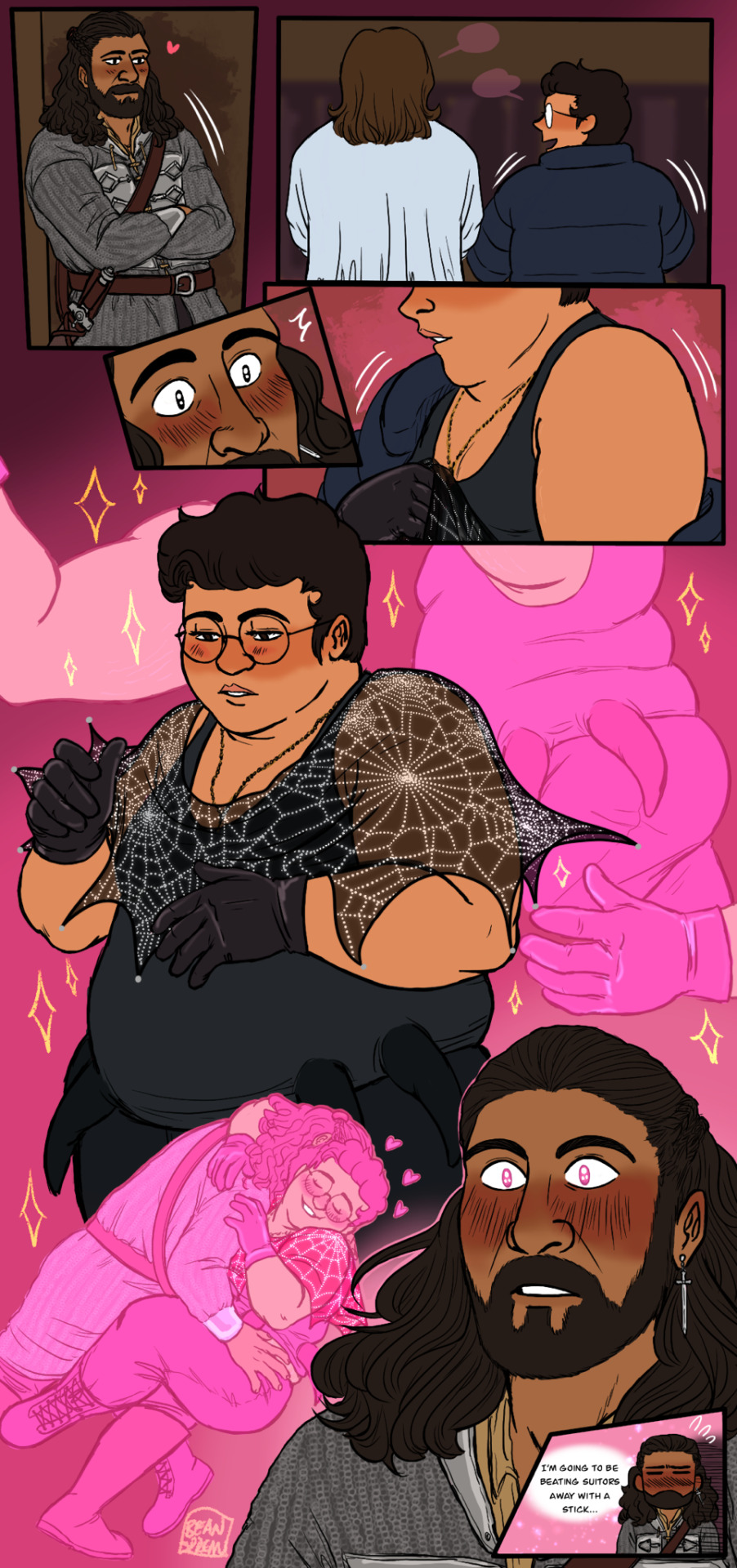
Support me on Patreon or send a tip on Kofi!
A commission from andieandiiandee(@TikTok) based on chapter 14 of “Hounds of Love” by @andiforyou!! ❤️
(ID in alt and under cut)
ID: 1. Waist up of human Nandor dressed in a chainmail shirt with chest plating, a silver sword dangling from his left ear, a brown leather belt, and a brown leather baldric over his shoulder attached to a real sword at his hip. His hair is half up, twin braids from his temples forming a bun at the crown of his head and held in place by a leather clasp threaded with a stick. He is leaning against a doorframe, arms crossed, and staring offscreen with hooded eyes and a small smile, a pink heart floating by his face. 2. What Nandor is looking at. Waist up of Jeremy and Guillermo from the back as they chat idly, the vague idea of a coat rack in front of them. Jeremy is wearing long white robes. Guillermo, half turned toward Jeremy with a smile as they chat, is making motions to shrug off his puffy winter coat. 3. Extreme closeup of Nandor's eyes as they fly open in shock, cheeks flushing red. 4. Close up of Guillermo in profile, from the bridge of his nose to just below his chest, as he shrugs his coat off to reveal his bare shoulder and arm in a plain black tank top, a golden chain around his neck disappearing into the shirt. His right hand, wearing a leather glove, pulls out a piece of black fabric with a dotted white design. 5. Hips up of Guillermo from Nandor's POV on a glowing pink background, surrounded by golden sparkles, as he drops the coat completely and throws a poncho over his shoulders to complete his outfit. He is paused in motion, eyes downcast, pink mouth pursed, arms raised chest-high as the poncho flutters into place around his shoulders. It is black and translucent, decorated with a silver beadwork pattern of spiderwebs. The end of the poncho hits right at his waist line, edges scalloped like bat wings with silver pearls adorning each peak. Four short makeshift spider legs are sewn to the bottom of his tank top, two on each side. In the background are pink-tinted close ups in Nandorvision: the flex of Guillermo's bicep, the stretch of his fingers beneath the glove, and the roll of his back and stomach beneath the tight tank top as his arms stretch overhead. 6. A pink-tinted Nandorvision fantasy: full body of Nandor and Guillermo in their current outfits as Nandor grabs Guillermo at the waist and dips him, knee pressing forward between his legs and head dipped to mouth at his neck. Guillermo's arms are looped around Nandor's shoulders and he is smiling blissfully, hearts floating around his head, cheeks flushed as he tilts his head to allow Nandor access to his throat. His left leg hitches around Nandor's hip as Nandor's right hand creeps beneath the hem of his tank top. 7. Shoulders up of the real Nandor, staring slackjawed at the visions before him, cheeks flushed red and eyes wide, irises gone pink to reflect where his mind is at. 8. Small corner panel of Nandor, chest up and casting a shadow on a sparkly pink background as he comes back down to earth. He blushes, flustered, and closes his eyes with resignation, thinking to himself: "I'm going to be beating suitors away with a stick..." /end ID
#wwdits#nandermo#mlm#hounds of love#fic rec#human nandor#nandor the relentless#guillermo de la cruz#jeremy wwdits#what we do in the shadows#what we do in the shadows fx#my art#fanart#fan comic#image described
409 notes
·
View notes